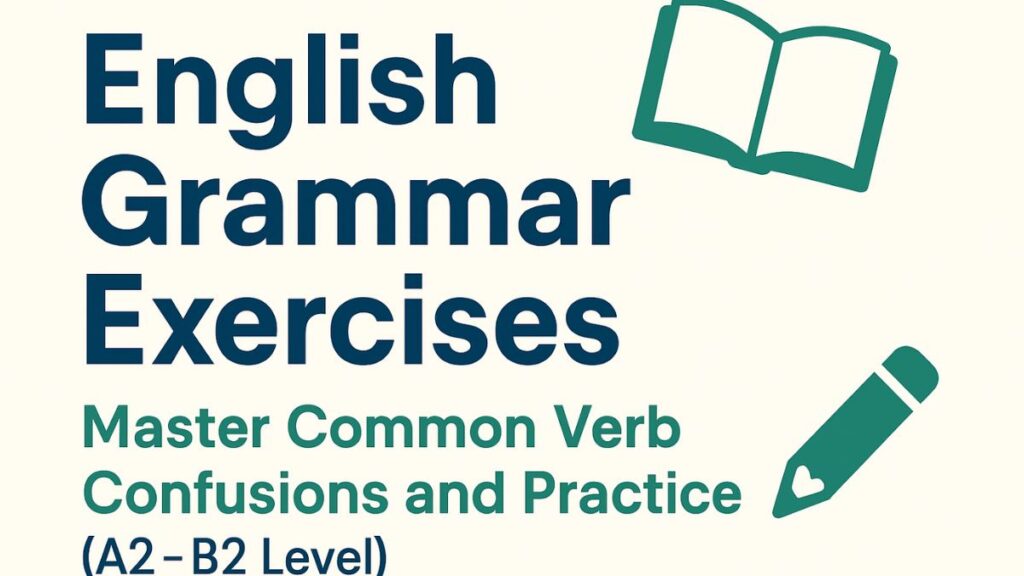Introduction
Ever wondered why mastering verbs can feel like solving a puzzle? For A2-B2 learners, understanding verb confusions is a game-changer. It’s not just about rules – it’s about building confidence in speaking and writing.
Lohuana, one of our learners, shared, “Your logical way to teach is too easy to understand.” Oksana added, “Best-structured and most clear course.” These testimonials highlight how structured English Grammar Exercises can make a difference.

Our resources include interactive tools to make learning practical and engaging. Whether it’s modal verbs, phrasal verbs, or reported speech, we’ve got you covered with a variety of exercises that cater to different learning styles.
These interactive components are designed to help you apply what you learn in real-world situations, making the learning process effective and enjoyable. By practicing with these tools, learners can see immediate improvements in their understanding and usage of English verbs, which can significantly enhance their communication skills.
Maria summed it up perfectly: “Explained it perfectly.” Her feedback reflects the clarity and effectiveness of our approach. Ready to take your skills to the next level? Let’s dive in!
Key Takeaways
- Mastering verb confusions boosts speaking and writing confidence.
- Structured exercises make learning easier and more effective.
- Downloadable worksheets and interactive tools enhance practical learning.
- Comprehensive coverage of topics like modal and phrasal verbs.
- Real-world applications ensure skills are immediately useful.
Introduction to English Grammar Exercises
Building strong grammar skills starts with the right exercises. Structured practice helps learners understand rules and apply them confidently. For A2-B2 learners, these activities bridge gaps in verb usage and sentence structure, allowing them to develop a more nuanced understanding of English. By engaging with targeted exercises, learners can gradually build their proficiency, making it easier to express themselves clearly and accurately in both spoken and written forms.
Key categories include:
- Adjectives and adverbs: Enhance descriptive language, enabling learners to paint vivid pictures with their words and add depth to their communication.
- Articles: Master “a,” “an,” and “the,” which are essential for proper noun usage and can significantly alter the meaning of sentences.
- Phrasal verbs: Understand combinations like “look up” or “give in,” which are commonly used in everyday conversation and can often be confusing for learners.
- Clauses: Learn to build complex sentences, which helps in creating more sophisticated and varied sentence structures that enhance writing style.
- Tenses: Practice past, present, and future forms, which are crucial for conveying time accurately in communication and storytelling.
These exercises are designed to be accessible. Whether at home or on the go, learners can use worksheets and mobile-compatible drills that cater to different learning styles. This flexibility ensures consistent practice, allowing learners to integrate grammar exercises into their daily routines and reinforcing their skills over time.
Mastering grammar is about rules and improving reading comprehension and speaking confidently, which are essential skills in both academic and everyday contexts. Structured exercises make this journey easier and more effective, allowing learners to engage with the material actively and develop a stronger command of the language over time.
-------- Continua após a publicidade --------
| Category | Focus Area |
|---|---|
| Adjectives | Descriptive language that enhances imagery and clarity in writing, making it more vivid and engaging for readers. |
| Articles | Definite and indefinite usage, which helps learners understand specificity and generality in communication, crucial for effective expression. |
| Phrasal Verbs | Verb-preposition combinations that can significantly alter meaning, making them vital for fluency and understanding of colloquial speech. |
| Clauses | Sentence complexity that allows for more nuanced and sophisticated expressions, enabling learners to convey detailed thoughts and ideas. |
| Tenses | Time-based verb forms are essential for situating actions in time, which is crucial for clear communication and storytelling. |
With the right resources, learners can tackle grammar challenges head-on. By engaging with targeted exercises and consistent practice, they can build confidence and proficiency in their language skills. Start today and see the difference structured practice can make.
Understanding Verb Confusions
Why do some verbs trip up even the most dedicated learners? Confusing verb pairs can make simple sentences feel like a maze, leading to frustration and misunderstandings. This confusion often arises because many verbs have similar meanings or functions, while they are used in distinct contexts.
For instance, the subtle differences in meaning between verbs like see and look can cause learners to hesitate. Understanding these challenges is the first step to mastering them, as it improves grammatical accuracy and enhances overall communication skills.
Common Verb Pairs That Cause Confusion
Certain verb pairs often lead to mistakes. For example, make and do are frequently mixed up. While make refers to creating something, such as making a cake or making a decision, do is about performing an action, like doing homework or doing a favor for someone.
The distinction can be subtle, yet it is crucial for clear communication. Similarly, let and make can confuse learners. Let allows someone to act, giving them permission or the opportunity to do something, while make forces them to, implying an obligation or requirement to complete a task.
Another tricky pair is used to and would. Both describe past habits, but used to emphasizes a discontinued action, indicating something that was once true but is no longer the case, such as “I used to play soccer every weekend.” In contrast, would focuses on repeated past events, often conveying a sense of nostalgia or routine, like saying “We would go to the beach every summer.” Understanding these differences can significantly enhance one’s ability to express past experiences accurately and effectively.

Why Verb Confusions Happen
Verb confusions often stem from irregular forms. For example, go becomes went in the past tense, which can be hard to remember for learners of English, especially since many verbs follow a regular pattern while others do not. This inconsistency can lead to mistakes when trying to convey actions that occurred in the past. Overlapping meanings also play a role in these confusions.
Phrasal verbs like take off and take up have different uses but similar structures, which can confuse learners who may not be familiar with the specific contexts in which each is used. For instance, “take off” can mean to remove something or for an aircraft to leave the ground, while “take up” refers to starting a new hobby or interest.
Modal verbs add another layer of complexity to the understanding of verb usage. Can and could both express ability, but could is often used for past or hypothetical situations, such as “I could swim when I was younger,” which indicates a past ability that is no longer true. These nuances can trip up learners who may struggle to grasp the subtle differences in meaning and usage. It’s essential to practice these distinctions in various contexts to build a more robust understanding of how to use these verbs correctly.
Here are some actionable tips to tackle verb confusions: first, practice identifying and using verbs in context. This means paying attention to how verbs are used in sentences, whether in reading materials or spoken language. Second, regular practice is crucial; using exercises designed to reinforce correct usage can help solidify your understanding. Finally, memorizing irregular forms can be beneficial; creating lists or flashcards can help with recall and make it easier to remember these exceptions to the rules.
- Context is key: Pay attention to how verbs are used in sentences.
- Practice regularly: Use exercises to reinforce correct usage.
- Memorize irregular forms: Create lists to help with recall.
By focusing on these strategies, you can turn verb confusions into opportunities for growth.
Practical English Grammar Exercises
Structured practice turns confusing verbs into clear, confident choices. These drills help learners apply rules in conversations, emails, and tests, allowing them to internalize the correct forms and usages of verbs. For instance, when practicing with modal verbs, learners can engage in role-playing scenarios that mimic real-life situations, thereby reinforcing their understanding of when to use terms like must and might. Focused activities target common stumbling blocks, such as distinguishing between similar verbs and their contexts, which is essential for effective communication. By incorporating varied exercises, such as fill-in-the-blank or sentence transformation tasks, learners can further solidify their grasp of the material.
Exercises for Modal Verbs
Modal verbs like must and have to often trip up learners. Try these exercises:
- Permission vs. possibility: “You may leave early” (allowed) vs. “It might rain” (uncertain). In this context, understanding the nuances between permission and possibility is crucial. For example, “You may go to the party” implies that permission has been granted, while “It might snow tomorrow” indicates that there is a chance of snow, but it is not certain.
- Obligation scenarios: “She has to attend” (external rule) vs. “He must study” (personal urgency). Here, “has to” suggests a requirement imposed by someone else, while “must” reflects a personal conviction or necessity, highlighting the difference between external obligations and internal motivations.
Mix in prepositions like depend on or agree with for added complexity. Incorporating prepositions can deepen understanding of relationships between actions and subjects. For instance, “You can depend on him” indicates reliability, while “I agree with your point” shows alignment in opinion, enhancing the overall grammatical comprehension of learners.
Phrasal Verbs Practice
Phrasal verbs change meaning with context. Compare:
- “The car broke down” (mechanical failure).
- “She broke down crying” (emotional collapse).
Create sentences using take off (leave/remove) or turn up (arrive/increase volume). Phrasal verbs are particularly interesting because their meanings can vary significantly depending on the context in which they are used. For example, “take off” can refer to an airplane leaving the ground, or it can mean to remove an article of clothing. Similarly, “turn up” can mean to arrive unexpectedly or to increase the volume of music or sound. Understanding these nuances is essential for mastering English as it allows for more effective communication and comprehension. Practice creating sentences that illustrate these different meanings, which will help reinforce your grasp of phrasal verbs and their usage in everyday language.
Reported Speech Drills
Convert direct quotes to indirect speech. Example:
“I will call tomorrow,” she said.
Becomes: She said she would call the next day.
This transformation from direct to indirect speech is crucial for fluency in English, as it allows speakers to report what others have said without quoting them verbatim. For instance, if someone says, “I am going to the store,” you would convert it to: He said he was going to the store. This method not only helps in conversations but also in writing, making it more concise and fluid.
Add mixed tenses: “I had finished when he arrived” → She said she had finished when he arrived.
By incorporating mixed tenses, you can convey a more complex timeline of events. This skill is particularly useful in storytelling or reporting, where the sequence of actions is important. For example, you might say, “She mentioned that she had already eaten before the meeting started,” which gives clarity to the timing of events.
These exercises build real-world skills. Download worksheets or try interactive quizzes for extra practice. Engaging with these resources will reinforce your understanding and boost your confidence in using indirect speech in various contexts, such as conversations, presentations, and writing assignments.
Enhancing Grammar Skills with Worksheets
Structured worksheets and interactive tools can transform your learning experience. These resources are designed to make practice engaging and effective. Whether you are working on verb conjugations or mastering adjectives and adverbs, these materials are tailored to your needs. They provide clear instructions and examples and allow for personalized learning paths that cater to your individual pace and style.
For instance, interactive tools often include instant feedback, which helps you identify areas for improvement immediately, reinforcing your learning and boosting retention. Additionally, many worksheets incorporate real-life scenarios that make the practice relevant and relatable, enhancing your ability to apply these concepts in everyday situations.
Downloadable Grammar Worksheets
Printable worksheets are a great way to practice at your own pace. They focus on key areas like verb conjugation and differentiating between quick and quickly. These exercises help you identify and correct common errors.
For example, one worksheet might ask you to choose the correct word:
- She runs quick/quickly to catch the bus.
- He is a quick/quickly learner.

Interactive Online Exercises
Platforms like English Across the Curriculum offer topic-based practice that is specifically designed to enhance language skills through the lens of various subjects. These vocabulary exercises not only integrate grammar into subjects like science and history but also allow learners to see how language operates within different contexts. This approach makes it a great way to apply your skills in real-world contexts, helping to bridge the gap between theoretical knowledge and practical application.
GrammarBank’s video lessons are perfect for visual learners who benefit from seeing concepts in action. They cover everything from basic rules to advanced concepts, providing clear examples and engaging visuals that reinforce learning. Self-paced and accessible, these resources fit into any schedule, allowing learners to revisit complex topics as needed, ensuring thorough understanding and mastery over time.
Here’s a quick comparison of the platforms, highlighting their unique strengths:
| Platform | Focus | Features |
|---|---|---|
| English Across the Curriculum | Topic-based practice | Science, history themes, real-world application |
| GrammarBank | Video lessons | Self-paced, visual learning, interactive elements |
Timed quizzes on these platforms help you measure your improvement effectively. They provide immediate feedback, allowing you to identify areas of strength and those needing further attention. Consistent work with these tools ensures steady progress, making your learning journey both structured and rewarding.
Are you ready for the next step?
Once you’ve mastered the difference between commonly confused verbs like make vs. do or come vs. go, it’s time to tackle one of the most frequent grammar challenges for English learners: the use of the Present Perfect and Past Simple.
👉 Check out our next guide: Present Perfect vs Past Simple – How to Use Them in Real-Life Situations (B1)
Conclusion
Consistent practice is the key to mastering vocabulary and grammar. Maria, one of our learners, shared, “It was easy to learn – you explained it perfectly.” Her experience highlights how structured resources can make a significant difference in the learning process, demonstrating that with the right guidance, learners can overcome challenges and achieve fluency. The clarity of instruction she received allowed her to grasp complex concepts quickly, reinforcing the idea that effective teaching methods are crucial for successful learning.
Whether you’re at home or work, applying these skills can boost your confidence tremendously. Writing emails or participating in meetings becomes easier with a strong grasp of grammar, as it enables you to communicate your ideas clearly and professionally. This newfound confidence not only enhances your ability to express yourself but also positively impacts your interactions with colleagues and clients, fostering better relationships and collaboration.
Explore membership benefits for advanced resources that can further aid your learning journey. CLICK HERE TO READ ABOUT HOW THE MEMBERSHIP CAN HELP YOU deepen your understanding and provide you with tools that cater to your specific learning needs. Start your journey today and see the difference consistent practice can make, as it transforms your language skills and opens up new opportunities for personal and professional growth.
FAQ
What are some common verb pairs that cause confusion?
Common verb pairs that often confuse learners include “make” vs. “do,” “say” vs. “tell,” and “lie” vs. “lay.” Understanding their distinct uses can improve accuracy in writing and speaking.
Why do verb confusions happen?
Verb confusions often arise due to similar meanings, overlapping contexts, or irregular forms. Lack of practice and exposure to real-life usage can also contribute to these errors.
How can I practice modal verbs effectively?
Practice modal verbs by using worksheets, interactive online tools, and real-life scenarios. Focus on their specific functions, such as expressing possibility, necessity, or permission.
What are the best ways to master phrasal verbs?
Master phrasal verbs by grouping them by theme or particle, practicing with contextual sentences, and using flashcards. Consistent exposure through reading and listening helps reinforce their meanings.
How can I improve my reported speech skills?
Improve reported speech by practicing sentence transformations, focusing on tense changes, and using exercises that mimic real conversations. Worksheets and drills can also strengthen your understanding.
Where can I find downloadable grammar worksheets?
Downloadable grammar worksheets are available on educational platforms like British Council, ESL Printables, and Teachers Pay Teachers. These resources cater to various skill levels and topics.
Are interactive online exercises helpful for grammar practice?
Yes, interactive online exercises provide immediate feedback and engage learners through quizzes, games, and timed activities. Platforms like Grammarly and Duolingo offer effective tools for practice.





2 thoughts on “English Grammar Exercises: Master Common Verb Confusions and Practice (A2–B2 Level)”